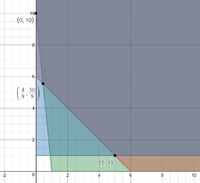vocampo0811
New member
- Joined
- Feb 1, 2020
- Messages
- 8
How to solve:
The Kalo Fertilizer Company makes a fertilizer using two chemicals that provide nitrogen, phosphate, and potassium. A pound of ingredient 1 contributes 10 ounces of nitrogen and 6 ounces of phosphate, while a pound of ingredient 2 contributes 2 ounces of nitrogen, 6 ounces of phosphate, and 1 ounce of potassium. Ingredient 1 costs $3 per pound, and ingredient 2 costs $5 per pound. The company wants to know how many pounds of each chemical ingredient to put into a bag of fertilizer to meet the minimum requirements of 20 ounces of nitrogen, 36 ounces of phosphate, and 2 ounces of potassium while minimizing cost.
a. Formulate a linear programming model for this problem.
b. Solve this model by using graphical analysis.
The Kalo Fertilizer Company makes a fertilizer using two chemicals that provide nitrogen, phosphate, and potassium. A pound of ingredient 1 contributes 10 ounces of nitrogen and 6 ounces of phosphate, while a pound of ingredient 2 contributes 2 ounces of nitrogen, 6 ounces of phosphate, and 1 ounce of potassium. Ingredient 1 costs $3 per pound, and ingredient 2 costs $5 per pound. The company wants to know how many pounds of each chemical ingredient to put into a bag of fertilizer to meet the minimum requirements of 20 ounces of nitrogen, 36 ounces of phosphate, and 2 ounces of potassium while minimizing cost.
a. Formulate a linear programming model for this problem.
b. Solve this model by using graphical analysis.

